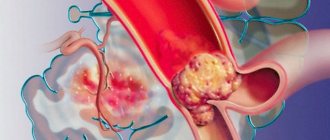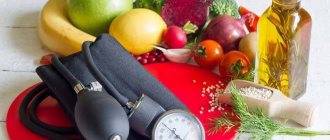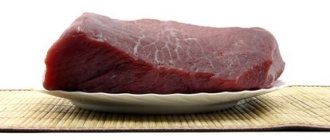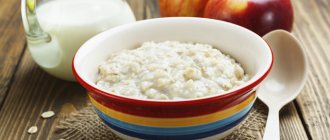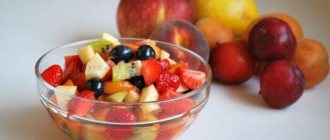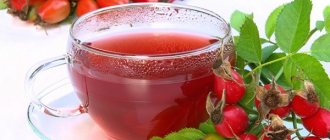A diet for high cholesterol by itself usually does not give the desired effect; it only helps in combination with taking medications. However, without it, treatment will not work.
When creating a menu, it is necessary to take into account not only the level of cholesterol in a person’s blood, but also his gender and age. There is no need to leave such a diet, since in this case you will have to adhere to a therapeutic diet for the rest of your life.
- Up to 40 years old
What does high cholesterol mean?
Cholesterol (cholesterol) is a steroid that is essential for the human body. It plays an important role in lipid metabolism and is involved in the production of hormones. This substance is present in all cells of the body, even in the brain. However, the situation is dangerous when cholesterol levels rise.
Transport of cholesterol molecules to tissues is carried out using proteins. They come in several types:
- High density lipoproteins (HDL). This is the so-called “good” cholesterol. They absorb excess fat, transport it to the liver, where it is processed into bile acids, which are subsequently excreted through the intestines.
- Low density lipoproteins (LDL). This is “bad” cholesterol. They deliver its molecules to tissues. When LDL levels are elevated, excess LDL is deposited to form plaques, leading to cardiovascular disease.
- Very low density lipoproteins (VLDL). They are considered the most dangerous type because they transport fats such as triglycerides from the liver to the tissues.
If a low-cholesterol diet is needed, this means that a person has high LDL levels and it is “bad” cholesterol that he needs to reduce.
Basic principles of the diet
A cholesterol-lowering diet with high cholesterol levels is followed throughout life. This is not a completely cholesterol-free diet, since it is impossible to eliminate all foods containing cholesterol from the diet. Recent studies have shown that if it is excluded completely, the situation will lead to neurological and endocrine disorders.
Basic principles of dietary nutrition:
- Consume at least 400 g of vegetables and fruits daily. Their share can even be increased. Starchy vegetables like potatoes and pumpkin are allowed to be consumed, but in limited quantities, no more than the physiologically acceptable norm. Their cholesterol load is low, but they contain carbohydrates.
- Consumption of vegetable protein through legumes, if there is no kidney disease.
- Fractional nutrition, in which the total amount of food is divided into 5-6 meals. This will help ensure drainage of the gallbladder.
- Limit salt intake to 5 g per day.
- Exclusion of pickled, salted and smoked foods, sweet soda.
- Sugar consumption at the level of 5 tsp. in a day. The quantity is calculated in total, including all drinks and dishes.
- Body weight control.
If necessary, you can carry out vegetable, apple or kefir fasting days. If you are overweight, start with a cottage cheese or fruit and vegetable low-cholesterol diet, and then move on to an anti-cholesterol diet plan.
Advantages and disadvantages of dietary nutrition
| benefits of dietary nutrition | dietary deficiencies in cholesterol |
| · food is affordable; | · no balance in the menu; |
| · wide variety of permitted products; | · due to the lack of carbohydrates, diet food is difficult to tolerate by the body; |
| · effectively reduces cholesterol levels; | · This diet is not suitable for all people. |
| · effectively fights excess weight. |
If you have a high cholesterol index, this diet is recommended to be followed for 90 days. With the right diet, you can bring lipids back to normal during this time, as well as lose extra pounds.
This diet should not be used for type 1 diabetes mellitus, as well as for pregnant and lactating women. Teenagers must undergo such nutrition under the strict supervision of a doctor.
Prohibited Products
A standard diet to lower LDL levels limits or completely eliminates foods rich in fat. Prohibited items include:
- fatty meats and fish;
- offal;
- cream and full fat milk;
- margarines.
This alone can reduce cholesterol levels by 10-15%. Sometimes you don't even have to diet. It is enough to give up the listed products and include more vegetables and fruits, fish and seafood, and vegetable fats in your daily menu.
When planning your diet, it is important to remember that to lower cholesterol you do not need to completely eliminate fat. Their share is determined individually, depending on the severity of the disease. Sometimes it has to be reduced by 20%, but usually the restrictions are not so significant. Vegetable oils should also be consumed with caution, not more than normal, since they contribute to the accumulation of harmful substances in the body.
When sugar levels are high, the amount of carbohydrates is reduced. But with normal body weight and glucose levels, you can slightly increase the proportion of complex carbohydrates to provide the body with energy.
To reduce fat and cholesterol in your daily menu, you must follow these rules:
- Fat is trimmed from meat, skin is necessarily removed from poultry;
- vegetables are never cooked with meat, as they absorb fats;
- any recipe is adapted to this diet, reducing its fat content (for example, using sour cream with a lower fat content);
- Rice dishes, mashed potatoes, and pasta are prepared without butter.
You should also use non-stick cookware to avoid frying.
Does red caviar contain cholesterol?
There is quite a lot of cholesterol in red caviar, from 300 to 580 mg for every 100 grams of product, which is equal to or exceeds the maximum permitted daily intake. This concentration is due to the high percentage of animal fats.
However, most of the fats (up to 80%) are Omega-3 and other polyunsaturated acids. Thanks to them, the level of high-density lipids (HDL) increases, which contribute to the removal of LDL (“bad” cholesterol). Therefore, despite the high content of the component in the product, the level of “harmful” cholesterol in the body is significantly reduced.
Difference between LDL and HDL.
Authorized Products
The cholesterol-lowering diet allows the following foods listed:
- Lean meats and fish. The most useful fish is considered to be cold sea fish, which contains omega-3 acids that affect fat metabolism.
- Vegetable oils that bind and remove cholesterol (this is not only olive, but also soybean or rapeseed oil).
- Fermented milk products, including cottage cheese, sour cream, low-fat cheese.
- Nuts, especially walnuts and almonds, as they contain large amounts of vitamins, folic acid, magnesium and arginine. However, they contain a lot of calories, so you need to eat them in small quantities.
- Cereals - buckwheat, rice, oatmeal.
- Eggs - no more than 2-4 per week, depending on health status.
- Soy products. They are very useful, but we are talking only about high quality products, for example, you can eat tofu.
- Products containing dietary fiber are wheat and oat bran.
- Fruits, especially apples and citrus fruits, as they help lower blood pressure and prevent blood clots.
You can eat bread, but only yesterday’s baked bread or in the form of toast. Tea is also included in the daily diet. But to reduce potential harm, it should be weak and with a minimum amount of sugar.
Food products that make up the diet
This table shows food products with different cholesterol contents, so these data can be used to create a daily menu for people with a high cholesterol index.
Prohibited foods must be completely excluded from the diet at the initial stage of the diet, and with good indicators of lipid reduction, you can very rarely supplement a cholesterol-free breakfast or lunch with a small piece of lard, or butter, or one chocolate candy.
Allowed food products can be eaten daily and the menu can be combined at your discretion so that your daily meals are as varied as possible:
| name of food | recommended foods for dietary nutrition | foods prohibited for dietary nutrition |
| sea fish | hake fish; | · salmon fish; |
| · lean blue whiting; | · fatty mackerel; | |
| · low-fat pollock; | · fatty sardine; | |
| · pollock fish; | · herring fish; | |
| · sea pike. | · oysters; | |
| can be included in the menu 3 times a week | · crayfish and shrimp; | |
| · semi-finished fish products. | ||
| small quantities are allowed, there are river varieties of fish | ||
| chicken eggs | up to 2 - 3 eggs per week | egg yolk |
| fat | · sunflower oil; | · pig fat; |
| · olive oil; | · margarine; | |
| · corn oil; | · palm trans fat; | |
| · flaxseed and soybean oil. | · cow butter; | |
| · animal fat. | ||
| meat products | · young veal; | · pork; |
| · rabbit meat; | · cow meat; | |
| · chicken meat without skin; | · lamb meat; | |
| · turkey meat without skin. | · goose meat; | |
| include meat in the menu 2 - 3 times a week | · duck meat; | |
| · ready-made and semi-finished sausages; | ||
| by-products; | ||
| · meat pates. | ||
| dairy products | · milk without fat; | · cottage cheese with a fat content of 5.0% and higher; |
| · kefir with zero fat content; | · fat sour cream and cream; | |
| · yogurt with a minimum amount of fat; | · ice cream; | |
| · cheese no more than 10.0% - 15.0%; | · condensed milk; | |
| · cottage cheese with zero fat content. | · processed cheeses; | |
| · hard cheese. | ||
| vegetables | frozen and fresh vegetables, as well as legumes | potato |
| fresh fruits | fresh or frozen fruits, except bananas, as well as any variety of grapes | · fruits in chocolate and sugar; |
| salted or chocolate peanuts; | ||
| · salted pistachios; | ||
| · hazelnuts. | ||
| cereals | · bakery products made from whole grain or rye flour; | · polished rice; |
| · wild rice; | · semolina; | |
| · oatmeal; | · buckwheat in small quantities. | |
| · Wheat groats; | ||
| · barley grits. | ||
| confectionery baked goods | · oat cookies; | · biscuit and butter cookies; |
| · unsalted crackers; | · buns and pies; | |
| · breads. | · pastries, cakes; | |
| · puff pastry | ||
| sweet desserts | · low-fat puddings; | · chocolate; |
| · jelly without sugar; | · confectionery creams; | |
| · frozen juice. | · toffee; | |
| · sweet marmalade; | ||
| · marshmallows and marshmallows; | ||
| · sugar; | ||
| · candies. | ||
| soft drinks | · unsweetened juice; | · cocoa, as well as coffee with added milk; |
| · green or herbal tea; | · alcohol; | |
| · the coffee is not strong; | · sweet carbonated water. | |
| · mineral water without gas. |

Olive oil
Dish recipes
The need to follow an anti-cholesterol diet does not mean that a person is forced to eat the same foods all the time.
Using products that lower cholesterol, you can create a healthy and tasty menu for proper nutrition.
Citrus marmalade

Citrus fruits contain a lot of pectin, which is involved in digestion processes. It forms a highly viscous mass that helps remove cholesterol from the body before it enters the blood. Citrus fruits are good in any form. They can be eaten raw, in fruit salad, and are also used to make marmalade.
To prepare it take:
- orange - 1 pc.;
- grapefruit - 1 pc.;
- lemon - 1 pc.;
- sugar - 0.5 kg;
- water - 500 ml.
Preparation:
- Citrus fruits are washed and the juice and pulp are squeezed out of the fruits.
- The coarse white fibers are removed from the peel and cut into thin strips.
- The raw materials are placed in a pan.
- Add juice and water.
- Cook for 12-20 minutes.
- Add sugar and keep on low heat until the mixture reaches a viscous state. When it cools down, it will become marmalade.
White bean soup with herbs
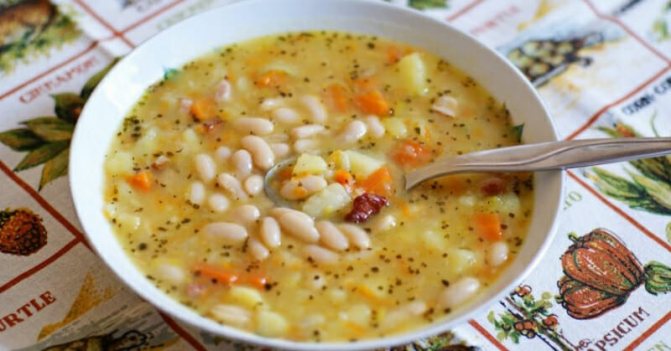
Legumes - lentils, beans, peas - contain dietary fiber that is beneficial for the cardiovascular system. They contain a lot of protein and can replace fattier meat in the diet. They are prepared in different ways. Mediterranean cuisine includes many options for dishes with legumes. For example, you can make white bean soup with herbs.
For this you will need:
- dry white beans - 1 tbsp.;
- onion - 1 pc.;
- carrots - 1 pc.;
- chopped celery stalk - 1 pc. ;
- weak chicken broth - 0.5 l;
- water - 0.5 l;
- salt and spices - to taste.
Preparation:
- The beans are soaked overnight and then boiled for 2 hours. It turns out approximately 500-600 g of the finished product.
- Stew onions, carrots and celery for 8-10 minutes.
- Pour beans into the pan and add vegetables.
- Fill with broth and water.
- Add salt and spices.
- Bring to a boil.
- Leave on low heat for another 15 minutes.
- Half of the legume and vegetable mass is taken out of the soup, blended in a blender, and returned back to the remaining ingredients.
It turns out to be a very thick soup, to which different types of fresh herbs are added before serving.
Carrot cutlets

Carrots are another product that helps lower cholesterol, including due to the pectin it contains. You can make cutlets from it.
Necessary:
- medium carrots - 3 pcs.;
- eggs - 3 pcs. ;
- flour - approximately 5-6 tbsp. l. with a slide;
- salt - to taste.
Preparation:
- The carrots are chopped on a coarse grater.
- Add eggs, flour and salt.
- Everything is mixed.
- Form cutlets and cook in a non-stick frying pan without oil or in the oven, turning several times.
Sweet pepper salad

Sweet pepper helps strengthen blood vessels and remove cholesterol. You can make a healthy salad from it.
To do this you need:
- pepper - 2 pcs.;
- red onion - 2 pcs.;
- greens - to taste;
- vegetable oil - for dressing.
Preparation:
- Chop vegetables.
- Sprinkle with herbs.
- Season with vegetable oil.
Baked eggplants with ham

These vegetables contain a lot of potassium and normalize metabolism. You can cook eggplants baked with lean ham.
To do this you will need:
- eggplants - 2 pcs.;
- ham - 100 g;
- low-fat sour cream - 3 tbsp. l. ;
- grated cheese - 70-80 g;
- greens - to taste.
Preparation:
- Wash the eggplants, cut them in half, and place them on a baking sheet.
- The ham is chopped and mixed with chopped herbs.
- Add sour cream.
- Spread the mixture on top of the eggplants and bake for 15 minutes.
You can experiment with any familiar recipes, changing the ingredients into healthier ones.
Fast food and semi-finished products
It is difficult to find a more disgusting food for humans. The standard set - a large cola, fries and a hamburger - is a cannon shot even for a healthy person. A lot of sugar is added to all the food offered by fast food - this makes it seem tastier.
Even the bun on a hamburger is much more harmful than a regular white bun - in order for it to be toasted appetizingly, a lot of sugar was added to it. 0.5 ml of cola or any other sweet carbonated drink contains 50-55 g of sugar, with the norm for a healthy person being 25 g per day!
Sugar is also present in sauces. It doesn’t make much sense to replace a carbonated drink with juice - juice from a pack does not contain much less sugar. In addition to sugar, fast food contains large amounts of transgenic fats. A safe consumption rate for a healthy person is 1% of the daily diet.
A standard serving of French fries contains 35% trans fats, which clog blood vessels. It should be understood that if you have problems with cholesterol and sugar, even occasional consumption of fast food is unacceptable.
Okay, everyone almost agreed on the dangers of fast food. But why are semi-finished products bad?
- You have no control over the contents of these products;
- They also add “more sugar” for taste, as well as monosodium glutamate, which makes you eat more;
- Pre-frying of semi-finished products (pancakes, for example) is most likely done using transgenic fats - after all, everyone wants to get a cheap product;
- One of the main methods of preparing semi-finished products is frying.
If you can’t resist dumplings, if you don’t have much time, prepare semi-finished products yourself and freeze them for an emergency.
Diet for high cholesterol in women
With normal levels of cholesterol in the blood, there is no need for an anti-cholesterol diet; it can even be harmful. Therefore, it is necessary to know the indicators at which such nutrition is indicated. For women, the norm is reflected in the following table:
| Age | Total cholesterol, mmol/l | "Bad" cholesterol mmol/l | “Good” cholesterol, mmol/l |
| 35-40 years | Up to 6.27 | Not higher than 4.45 | Not higher than 2.12 |
| 40-45 years | Up to 6.53 | Not higher than 4.51 | Not higher than 2.28 |
| 45-50 years | Up to 6.66 | Not higher than 4.82 | Not higher than 2.25 |
| 50-55 years | Up to 7.15 | Not higher than 5.21 | Not higher than 2.38 |
| 55-60 years | Up to 7.77 | Not higher than 5.44 | Not higher than 2.35 |
| 60-65 years | Up to 7.69 | Not higher than 5.80 | Not higher than 2.38 |
You need to take the appropriate blood tests and act in accordance with the results obtained. If “bad” cholesterol is higher than normal, an anti-cholesterol diet is necessary. It has been followed for a long time. Depending on your health, it may be necessary throughout your life.
A sample menu for 7 days for women looks like this:
| Day of the week | Diet |
| Monday |
|
| Tuesday |
|
| Wednesday |
|
| Thursday |
|
| Friday |
|
| Saturday |
|
| Sunday |
|
Amendments to this menu are made taking into account age and the presence of other chronic diseases. For example, for women over 60 years of age, it is better to limit meat in favor of fish and dairy products. This is especially true for those who suffer from arthritis and arthrosis, since meat contains substances that promote joint inflammation. If you have high sugar levels, you need to limit carbohydrates.
Menu for the day
A diet for high cholesterol and blood sugar involves 5 meals a day and looks like this:
- For breakfast, eat a portion of buckwheat porridge with olive oil. Wash it down with tea without sugar.
- Use apples as a snack.
- For lunch, prepare chicken soup and bake fish with vegetables. Wash it down with pomegranate juice.
- For an afternoon snack, eat cottage cheese with minimal fat content.
- For dinner, boil potatoes and cook fish. Wash it down with tea without sugar.
In the described example of a daily menu, there are enough proteins, carbohydrates and vitamins for the normal functioning of the body while gradually clearing cholesterol deposits. This diet additionally helps to increase stamina, reduce body weight and get rid of many health problems.
Features of the anti-cholesterol diet in men
The normal cholesterol table for men is as follows:
| Age | Total cholesterol, mmol/l | "Bad" cholesterol mmol/l | “Good” cholesterol, mmol/l |
| 35-40 years | Up to 6.99 | Not higher than 4.90 | Not higher than 1.60 |
| 40-45 years | Up to 6.94 | Not higher than 4.82 | Not higher than 1.73 |
| 45-50 years | Up to 7.15 | Not higher than 5.23 | Not higher than 1.66 |
| 50-55 years | Up to 7.17 | Not higher than 5.10 | Not higher than 1.63 |
| 55-60 years | Up to 7.15 | Not higher than 5.26 | Not higher than 1.84 |
| 60-65 years | Up to 7.15 | Not higher than 5.44 | Not higher than 1.91 |
A sample menu for a week for a man might look like this:
| Day of the week | Diet |
| Monday |
|
| Tuesday |
|
| Wednesday |
|
| Thursday |
|
| Friday |
|
| Saturday |
|
| Sunday |
|
Men also have age-related dietary features associated with the fact that physical activity gradually decreases, so less protein is needed than during intense training.
Age-related dietary patterns
If you have high bad cholesterol, you need to monitor your diet, but it is important to do this taking into account age-related characteristics.
Up to 40 years old
The metabolic rate is still high, but gradually begins to decline. The main goal of the diet is to speed up the metabolic process.
At this time, animal protein is still important, so you need to maintain the consumption of lean meat at least 3-4 times a week.
At 40-50 years old
At this time, hormonal changes begin in the body, and the need for animal protein decreases.
It is recommended to reduce meat consumption to 2 times a week and include more fish dishes in the diet. Instead of coffee, it is better to drink herbal or ginger tea.
At 50-60 years old
The rate of metabolic processes continues to slow down, which reduces the role of cholesterol, which is no longer needed in such quantities.
At this time, you should completely abandon whole milk, replacing it with fermented milk products.
After 60 years
You can eat meat no more than once a week, eggs - a maximum of 3 per week. The body may become deficient in iron and iodine, so it is recommended to consume more buckwheat, sea fish and other foods containing these substances.
Diet indications for lowering blood cholesterol

A cholesterol diet is great for treating diseases such as:
- increased amount of triglycerides in the blood;
- obesity;
- blood pressure increased to 140 per 90 mmHg. Art. and more;
- presence of type II diabetes mellitus;
- past illnesses of myocardial infarction and stroke.
However, you should not resort to a diet only after the onset of the disease. It is advisable to use the diet as a preventive measure against unwanted diseases and complications at least once every 3 months, especially after 40 years.
